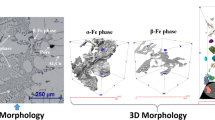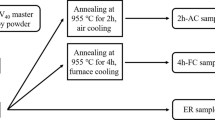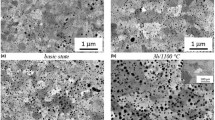Abstract
Systematical experiments have been carried out to investigate the mechanism of cracking and disintegration in the Mn–Al–Fe–Si master alloys. It revealed that pulverization of this alloy is due to the internal stress caused by volume change and hydrolysis. The earlier volume change associated with both the phase transition of Mn-content phase and the solidification process of ζ-FeSi2 led to micro cracks. Through the micro cracks channel, the further volume change took place due to the Al2O3 expansion which was produced by the hydrolysis of aluminum phosphide and carbide when they contacted air. The two steps interacted with each other and led to complete disintegration of the alloys together. However it has been found that Ti can prevent the alloy hydrolysis due to the formation of stable titanium phosphide and carbide instead of the unstable aluminum phosphide and carbide, but it can not stop the earlier volume expansion.






Similar content being viewed by others
References
Mikhailov G G, and Chernova L A, Russ Metall, 2008 (2008) 727.
Taguchi K, Ono-Nakazato H, Usui T, Marukawa K, Katogi K, and Kosaka H, Isij Int, 45 (2005) 1572.
Volkov I G, Fomin N A, Gordienko M S, Monastyrskii V Y, But V P, and D’Yakonov V M, Metallurgy 30 (1986) 123.
Fujisawa T, and Sakao H, Tetsu- to- Hagane 63 (1977) 1494.
Inoue A, Yano N, and Matsuzaki K, J Mater Sci 22 (1987) 123.
Zhao J Z, Ratke L, and Feuerbacher B, Model Simul Mater Sci Eng 6 (1998) 123.
Carlberg T, and Fredriksson H, Metall Mater Trans A 11 (1980) 1665.
Horn Q, Heckel R, and Nassaralla C, Proceedings of 56th Electric Furnace Conference, Iron & Steel Society, New Orleans, (1998), p 343.
Stellman J M, Encyclopaedia of Occupational Health and Safety (4th Ed), International Labour Office, Geneva, 3 (1998), p 63.46.
Fluck E, The Chemistry of Phosphine, Springer, Berlin, (1973), p 64.
Gelwicks D H, Badanjek L A, Dodson C L, Jun H P, Rowe D T, and Rowe G D, Proceedings of 53th Electric Furnace Conference, Iron & Steel Society, Orlando, (1995), p 72.
Ohnuma I, Abe S, Shimenouchi S, Omori T, Kainuma R, and Ishida K, Isij Int 52 (2012) 540.
Sigfússon T, and Helgason Ö, Hyperfine Interact 54 (1990) 861.
Horn Q, Heckel R, and Nassaralla C, Metall Mater Trans B 29 (1998) 325.
Zhao Q, Xu G F, Ren C Z, and Zhang S R, J Rare Earth 19 (2001) 284.
Gao H J, Sci Technol Baotou Steel (in Chinese) 36 (2010) 21.
Cayless R B C, Alloy and Temper Designation Systems for Aluminum and Aluminum Alloy, Properties and Selection: Nonferrous Alloys and Special-Purpose Materials, ASM Handbook, ASM International, Novelty, (1990), p 121.
Stewart J R, Hillier A D, Hillier J M, and Cywinski R, Phys Rev B 82 (2010) 144439.
Kohara T, and Asayama A, J Phys Soc Jpn 37 (1974) 401.
Askeland D R, Fulay P P, and Wright W J, Instructor’s Solution Manual, The Science & Engineering of Materials, Cengage Learning, Stamford, (2011), p 18.
Mcalister A J, and Murray J L, Al–Mn (Aluminum–Manganes), Alloy phase diagrams, ASM Handbook, ASM International, Novelty, (1992), p 111.
Kubaschewski O, Iron-Binary Phase Diagrams, Springer, New York (1982), p 136.
Ma L H, Research on Al–Mn master alloys, MA thesis, Chongqing University, Chongqing (2006).
Walter H U, In Binary Systems with Miscibility Gap in the Liquid State, (eds) Feuerbacher B, Hamacher H, Naumann R J, Springer, New York, (1986), p 343.
Hodgson P, and Parker B A, J Mater Sci 16 (1981) 1343.
Poole C P, Encyclopedic Dictionary of Condensed Matter Physics, Elsevier, London (2004), p 806.
Johannesson B, and Sigfusson T l, 8th Int Ferroalloys Cong Proc, Science & Technology Press, Beijing, (1998), p 104.
Acknowledgments
The work was supported by the National High Technology Research and Development Program of China (863 program) (2008AA031203) and the National Natural Science Foundation of China (51174244). The authors are also grateful to Xinzhou Manganese Industry Co. Ltd. for their raw materials support on the experiment.
Author information
Authors and Affiliations
Corresponding author
Rights and permissions
About this article
Cite this article
Xie, Z.W., Zong, Z.Z., Fan, J.H. et al. Spontaneous Pulverization Action of Mn–Al–Fe–Si Alloys and Effect of Addition Ti on the Stability. Trans Indian Inst Met 67, 573–580 (2014). https://doi.org/10.1007/s12666-014-0384-9
Received:
Accepted:
Published:
Issue Date:
DOI: https://doi.org/10.1007/s12666-014-0384-9




